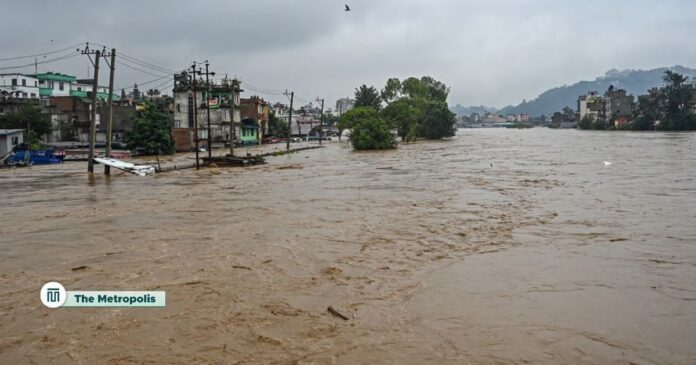Surging floodwaters engulfed low-lying neighbourhoods in Kathmandu, the capital of Nepal, on Sunday following intense monsoon rains that, according to police, killed at least 101 people across the Himalayan republic.
Across South Asia, deadly rain-related floods and landslides are typical during the monsoon season, which runs from June to September. However, experts claim that climate change is making these events more frequent and severe.
Since Friday, flash floods in multiple rivers have caused significant damage to the nation’s highways and submerged vast areas of eastern and central Nepal.
“There are 64 people missing and 101 dead,” police spokesman Dan Bahadur Karki told AFP.
“There is likely to be an increase in the death toll as our search and rescue mission proceeds in the affected areas,” he stated.
The nation’s weather bureau informed the Kathmandu Post newspaper that the Kathmandu valley received 240 millimeters (9.4 inches) of rain in the 24 hours leading up to Saturday morning.
The report said it was the most rain the capital had seen since 1970.
The Bagmati River burst its banks, submerging surrounding houses and cars as it cut through Kathmandu and its many tributaries.
In order to reach higher ground, residents forced their way through chest-deep water; as of Sunday morning, relief teams had saved about 3,300 people.
We sent more than 3,000 security guards into the area to support helicopter and motorboat rescue operations.
Rescue crews were using rafts to haul survivors to safety.
Landslides have blocked numerous highways connecting the nation’s capital to other regions, trapping hundreds of travelers.
“We have about eight locations, and landslides in different sections of the road have blocked them all,” said Bishwaraj Khadka, a traffic police officer in Kathmandu, on Saturday.
Domestic travel into and out of Kathmandu has resumed after inclement weather on Friday night forced a total cancellation of over 150 departures.
Seventy to eighty percent of South Asia’s annual rainfall occurs during the summer monsoon.
Every year, South Asia experiences widespread death and destruction due to the monsoon rains, which last from June to September. However, in recent years, there have been more fatal floods and landslides.
Experts believe that climate change has increased their frequency and intensity.
A landslip that struck a road in the Chitwan district in July forced two buses carrying 59 people into a river.
Only 20 bodies were found after the accident, despite the fact that three people managed to escape unharmed and that the search was hampered by rushing floodwaters.
This year, rain-related disasters in Nepal have claimed the lives of over 260 people.



